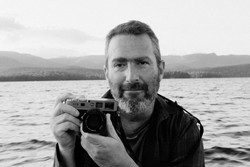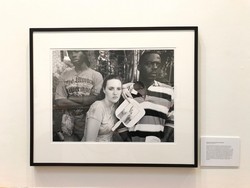The Ice House Gallery on campus, is a historical site that students walk past every day without ever knowing its significance in the lives of those who used to live in Wilson Hall before it became the University we now all call home.
This is what makes it the perfect place for Andrew Lichtenstein’s photography collection, Marked, Unmarked, Remembered: A Geography of American Memory to reside (from now until March 22).
This Gallery is a culmination of many years’ worth of photos taken in historical locations around the country, that aren’t often acknowledged for their significant places in history; but that’s not the only thing connecting these places.
Upon asking Lichtenstein how he found these locations, he shared the deeper connection of all the photos, saying, “it was all history that was important to me. So history that I was particularly interested in was the history of struggle and the history for the struggle for civil rights in this country.”
Lichtenstein began his career in photography while living in the east village of New York City several years ago, where he witnessed a modern struggle for civil rights.
What he’s seen provoked him to combat the injustice through documenting everything that went on.
The artist spoke on the event with, “When I was living in the East Village, they closed the park to the homeless. Then, I watched them take all the homeless people’s belongings and throw them in the trash truck.”
According to a friend of his and observer of the gallery, it was Thomson Square Park.
Lichtenstein continued, “I just felt that that was wrong; so all my friends and neighbors were throwing bricks and rocks at the police, and then they were getting beat up. [However,] I didn’t want to get beat up. [Then,] I quickly figured out if I brought a camera, I could participate, but not really suffer the consequences.”
In doing this, Lichtenstein was one of the sole people to capture a major violation of human decency and civil rights, which was scarcely publicized, but incredibly significant in the lives of those involved in the incident.
These photos became a corner stone to the collection that grew in the years after, where he captured locations that reflected the same history of being minimally acknowledged but deeply significant moments in time.
The most shocking of which is a portrait of an African American choir boy preparing for mass in the Emanuel AME Church in Charleston, S.C.
The photo radiates a calm and faithful energy, as if you could feel the people waiting in pews and hear the organ just about to play.
 In the photo, the boy is in a sanctuary that was designed by the son of Denmark Vesey, an ex-slave who purchased his own freedom and organized what would have been the largest slave rebellion in U.S. history.
In the photo, the boy is in a sanctuary that was designed by the son of Denmark Vesey, an ex-slave who purchased his own freedom and organized what would have been the largest slave rebellion in U.S. history.
After locals harassed African American church members, Vesey planned the rebellion for July 14, 1884 by seizing ships to sale to the liberated islands.
But after being betrayed by two of the slaves he was trying to emancipate, the rebellion stopped before it began by locals burning down the Emanuel Church and executing thirty-five accused rebels including Vesey.
After this, Vesey’s son, Robert Vesey (who had survived), rebuilt the church as it stands today.
However, this is also this same church that three years after this photo was taken, a white supremacist entered the church and killed the pastor and eight other African American parishioners in a devastating mass shooting.
On speaking about this photo, Lichtenstein said, “I think that [photo] is such a [significant] story because I think we were both gravitated to the same place for it’s historical importance for very different reasons.”
The artist turned this photo into not only a manifestation of how the church was born out of horrible crimes of racism and hate, but also a reminder that these concepts are still present threats today.
This photo is just one of dozens within the collection, all of which have deep and significant stories to accompany them.
The collection does an excellent job of presenting not only a display of great photography; but also exhibiting how each photo represents that location’s role in the still unraveling battle for civil rights in America.
IMAGE TAKEN BY Nicole Riddle
IMAGE TAKEN FROM Facing Change | Documenting America




